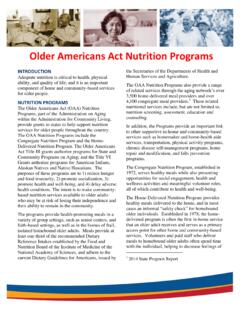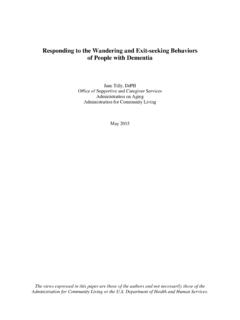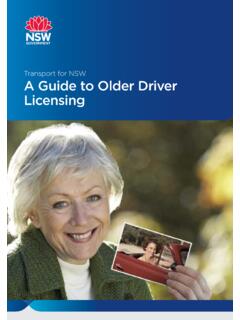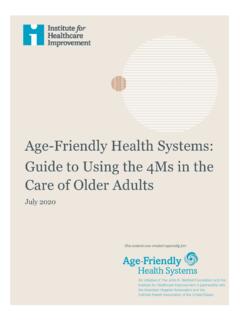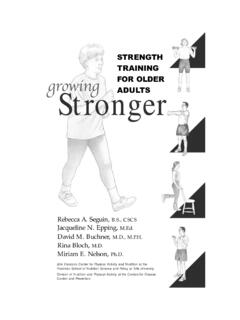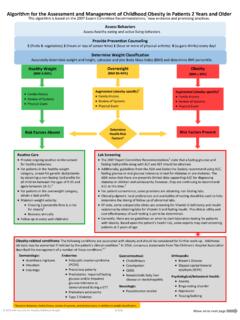Transcription of 2019 Profile of Older Americans - Home Page | ACL ...
1 2019 Profile OF Older Americans | PAGE 12019 Profile OF Older AMERICANSPUBLICATION DATE: MAY 2020 The Administration for Community Living, which includes the Administration on Aging, is an operating division of the Department of Health and Human Profile OF Older Americans | PAGE 2 Profile NotesThis report is prepared by the Administration on Aging (AoA), part of the Administration for Community Living, an operating division of the Department of Health and Human Services. AoA serves as an advocate for Older adults within the federal government and is working to encourage and coordinate a responsive system of family- and community-based services throughout the nation. AoA helps states develop comprehensive service systems which are administered by a national network of 56 state agencies on aging, 629 area agencies on aging, nearly 20,000 service providers, and 282 Title VI grantees representing over 400 Federally recognized tribes, made up of 281 Tribal organizations and 1 Native Hawaiian Profile incorporates the latest data available, but not all items are updated on an annual basis, so there is a combination of data ranging from 2015 to 2019 presented herein.
2 Principal sources of data are the Census Bureau, the National Center for Health Statistics, and the Bureau of Labor Statistics. A complete list of sources appears at the end of this report includes data on the American population age 65 and Older unless otherwise noted. The phrases Older adults and Older persons refer to that population. Age-adjusted estimates are used when available. The data presented refer to the noninstitutionalized population except where numbers in this report may not add up due to Profile OF Older Americans | PAGE 3 Profile Highlights Over the past 10 years, the population age 65 and Older increased from million in 2008 to million in 2018 (a 35% increase) and is projected to reach million in 2060. POPULATION MILLION (2008) MILLION (2018) MILLION (2060) Racial and ethnic minority populations have increased from million in 2008 (19% of the Older adult population) to million in 2018 (23% of Older adults) and are projected to increase to million in 2040 (34% of Older adults).
3 The number of Americans age 45-64 who will reach age 65 during the next two decades increased by 7% between 2008 and 2018. In 2018, more than one in every seven Americans is an Older adult. There were 93,927 persons age 100 and Older in 2018 ( of the total age 65 and Older population). In 2018, Older women outnumber Older men at million Older women to million Older MILLION Older MEN (2018) MILLION Older WOMEN (2018) In 2018, 23% of persons age 65 and Older were members of racial or ethnic minority populations: 9% were African Americans (not Hispanic), 5% were Asian (not Hispanic), were American Indian and Alaska Native (not Hispanic), were Native Hawaiian/Pacific Islander (not Hispanic), and of persons 65 and Older identified themselves as being of two or more races. Persons of Hispanic origin (who may be of any race) represented 8% of the Older population.
4 2019 Profile OF Older Americans | PAGE 4 In 2018, nearly 1 in 10 Older adults ( , or 5,146,000) lived below the poverty level. This poverty rate is not statistically different from the poverty rate among Older adults in 2017 ( ). NEARLY 1 IN 10 Older ADULTS LIVE BELOW POVERTY LEVEL (2018) A larger percentage of Older men (69%) were married as compared to Older women (47%). In 2019, 31% of Older women were widows. As of 2019, about 28% ( million) of Older persons lived alone (5 million men, million women). Among women age 75 and Older , 44% lived alone. The median income of Older persons in 2018 was $34,267 for men and $20,431 for women. The real median income (after adjusting for inflation) of all households headed by Older people increased by (which was statistically significant) between 2017 and 2018. Households containing families headed by persons age 65 and Older reported a median income in 2018 of $64,023.
5 The need for caregiving increases with age. In 2018, the percentage of Older adults age 85 and Older who needed help with personal care (21%) was more than twice the percentage for adults ages 75 84 (8%) and five times the percentage for adults ages 65 74 (4%). The 85 and Older population is projected to more than double from million in 2018 to million in 2040 (a 123% increase).AGE 85 AND OVER PROJECTED GROWTH (IN MILLIONS) (2018) (2040)2019 Profile OF Older Americans | PAGE 5 The Older American PopulationIn the United States, the population age 65 and Older numbered million in 2018 (the most recent year for which data are available). They represented 16% of the population, more than one in every seven Americans . The number of Older Americans has increased by million (or 35%) since 2008, compared to an increase of 4% for the under-65 2008 and 2018, the number of Americans age 45-64 (who will reach age 65 over the next two decades) increased by 7% from million to million.
6 The number of Americans age 60 and Older increased by 34% from million to 2018, million women and million men were over the age of 65. That s 125 women for every 100 men. At age 85 and Older , this ratio increased to 181 women for every 100 men. Since 1900, the percentage of Americans age 65 and Older more than tripled (from in 1900 to 16% in 2018), and the number increased more than 16 times (from million to million). The Older population itself became increasingly Older . In 2018, the 65-74 age group ( million) was more than 13 times larger than in 1900 (2,186,767); the 75-84 group ( million) was 20 times larger (771,369), and the 85+ group ( million) was more than 53 times larger (122,362).In 2018, persons reaching age 65 had an average life expectancy of an additional years ( years for women and years for men). A child born in 2018 could expect to live years, more than 30 years longer than a child born in 1900 ( years).
7 In 2018, million persons celebrated their 65th birthdays. Census Bureau population estimates showed an annual net increase between 2017 and 2018 of 917,687 people age 1980 and 2018, the centenarian population experienced a larger percentage increase than did the total population. There were 93,927 persons age 100 and Older in 2018 almost triple the 1980 figure of 32, GrowthThe Older population is expected to continue to grow significantly in the future. Growth slowed somewhat during the 1990s because of the relatively small number of babies born during the Great Depression of the 1930s. But the Older population is beginning to burgeon again as more than one-third (36%) of the baby boom generation is now age 65 and Profile OF Older Americans | PAGE 6 The population age 65 and Older increased from million in 2008 to million in 2018 (a 35% increase) and is projected to reach million in 2060.
8 By 2040, there will be about million Older persons, more than twice as many as in age 65 and Older represented 16% of the population in the year 2018 but are expected to grow to be of the population by 2040. The 85 and Older population is projected to more than double from million in 2018 to million in 2040 (a 123% increase).Number of Persons Age 65 and Older 1900 to 2060 (numbers in millions)Note: Increments in years are uneven. Lighter bars (2020, 2040, and 2060) indicate : Census Bureau, Population Estimates and and ethnic minority populations increased from million in 2008 (19% of the Older adult population) to million in 2018 (23% of Older adults) and are projected to increase to million in 2040 (34% of Older adults). Between 2018 and 2040, the white (not Hispanic) population age 65 and Older is projected to increase by 32% compared to 125% for Older racial and ethnic minority populations, including Hispanics (175%), African Americans (not Hispanic) (88%), American Indian and Alaska Native (not Hispanic) (75%), and Asians (not Hispanic) (113%).
9 2019 Profile OF Older Americans | PAGE 7 Marital StatusIn 2019, a larger percentage of Older men (69%) than Older women (47%) were married. Widows accounted for 31% of all Older women in 2019. There were more than three times as many widows ( million) as widowers ( million).Divorced and separated Older persons represented only 15% of all Older persons in 2019, which is unchanged from 2018. However, this percentage has increased since 1980, when approximately 5% of the Older population were divorced or separated/spouse Status of Persons Age 65 and Older , 2019 Source: Census Bureau, Current Population Survey, Annual Social and Economic ArrangementsOf the Older adults living in the community, more than half (57%) of persons age 65 and Older lived with their spouse (including partner) in 2019. Approximately million or 72% of Older men, and million or 49% of Older women, lived with their spouse.
10 About 28% ( million) of all Older adults living in the community in 2019 lived alone (5 million men, million women). They represented 21% of Older men and 34% of Older women. The proportion living alone increases with advanced age for both men and women. Among women age 75 and Older , for example, 44% lived Profile OF Older Americans | PAGE 8 Living Arrangements of Persons Age 65 and Older , 2019 Sources: Census Bureau, Current Population Survey, Annual Social and Economic Supplement 1967 to relatively small number of people ( million) age 65 and Older lived in nursing homes in 2018. However, the percentage increases dramatically with age, ranging from 1% for persons ages 65-74 to 2% for persons ages 75-84 and 7% for persons over age 85. Racial and Ethnic CompositionIn 2018, 23% of persons age 65 and Older were members of racial or ethnic minority populations 9% were African Americans (not Hispanic), 5% were Asian (not Hispanic), were American Indian and Alaska Native (not Hispanic), were Native Hawaiian/Pacific Islander, (not Hispanic), and of persons age 65 and Older identified themselves as being of two or more races.



